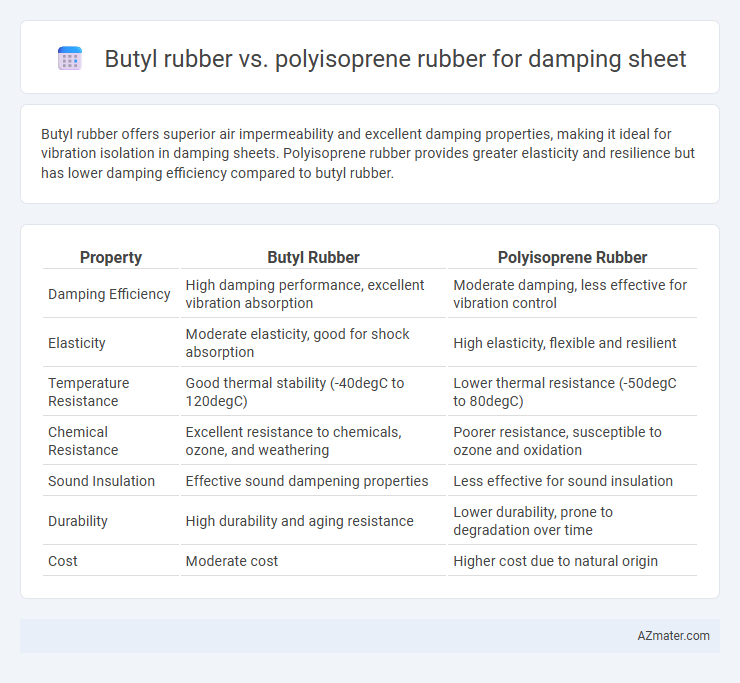Butyl rubber offers superior air impermeability and excellent damping properties, making it ideal for vibration isolation in damping sheets. Polyisoprene rubber provides greater elasticity and resilience but has lower damping efficiency compared to butyl rubber.
Table of Comparison
| Property | Butyl Rubber | Polyisoprene Rubber |
|---|---|---|
| Damping Efficiency | High damping performance, excellent vibration absorption | Moderate damping, less effective for vibration control |
| Elasticity | Moderate elasticity, good for shock absorption | High elasticity, flexible and resilient |
| Temperature Resistance | Good thermal stability (-40degC to 120degC) | Lower thermal resistance (-50degC to 80degC) |
| Chemical Resistance | Excellent resistance to chemicals, ozone, and weathering | Poorer resistance, susceptible to ozone and oxidation |
| Sound Insulation | Effective sound dampening properties | Less effective for sound insulation |
| Durability | High durability and aging resistance | Lower durability, prone to degradation over time |
| Cost | Moderate cost | Higher cost due to natural origin |
Introduction to Damping Sheet Materials
Butyl rubber and polyisoprene rubber are widely used materials for damping sheets, known for their vibration and noise reduction properties. Butyl rubber offers superior impermeability and aging resistance, making it ideal for long-term damping applications in harsh environments. Polyisoprene rubber provides excellent elasticity and resilience, enhancing energy absorption and vibration isolation in dynamic conditions.
What is Butyl Rubber?
Butyl rubber is a synthetic elastomer known for its excellent air impermeability, chemical resistance, and damping properties, making it ideal for vibration and noise control in damping sheets. Compared to polyisoprene rubber, which offers higher elasticity and natural resilience, butyl rubber provides superior damping efficiency and durability under varying environmental conditions. Its unique molecular structure allows it to absorb vibrations effectively, thereby enhancing the longevity and performance of damping materials.
What is Polyisoprene Rubber?
Polyisoprene rubber is a synthetic elastomer that closely mimics natural rubber's properties, offering excellent elasticity, tensile strength, and resilience ideal for damping sheets. Unlike butyl rubber, polyisoprene provides superior dynamic performance and flexibility, enhancing vibration absorption and noise reduction in industrial applications. Its molecular structure allows for efficient energy dissipation, making it a preferred choice where high durability and mechanical performance are critical.
Key Properties Comparison
Butyl rubber exhibits superior air impermeability and excellent vibration damping properties, making it ideal for high-performance damping sheets requiring long-term resilience and chemical resistance. Polyisoprene rubber offers exceptional elasticity and tensile strength, closely mimicking natural rubber, but it has lower resistance to ozone and weathering compared to butyl rubber. For damping sheet applications, butyl rubber's enhanced durability and damping efficiency provide a more stable performance under varied environmental conditions.
Damping Performance Analysis
Butyl rubber exhibits superior damping performance in damping sheets due to its high internal friction and excellent energy absorption properties, making it highly effective in vibration isolation applications. Polyisoprene rubber, while offering good elasticity and resilience, generally shows lower damping capacity because of its molecular structure, which limits energy dissipation during dynamic loading. Comparative studies reveal that butyl rubber's viscoelastic characteristics provide enhanced noise reduction and vibration control, outperforming polyisoprene in scenarios demanding high damping efficiency.
Durability and Longevity
Butyl rubber exhibits superior durability and longevity compared to polyisoprene rubber, making it ideal for damping sheets exposed to harsh environmental conditions. Its outstanding resistance to ozone, weathering, and chemical degradation ensures prolonged performance without significant loss of elasticity or vibration absorption. Polyisoprene rubber, while offering excellent elasticity and damping properties, generally exhibits lower resistance to oxidative aging, leading to a shorter service life in demanding applications.
Environmental Resistance
Butyl rubber exhibits superior environmental resistance compared to polyisoprene rubber, particularly in its excellent impermeability to gases and enhanced resistance to ozone, weathering, and aging. Polyisoprene rubber, while offering good elasticity and tensile strength, is more susceptible to degradation from UV exposure and oxidative elements. For damping sheet applications requiring long-term durability in harsh environments, butyl rubber provides a more robust solution due to its chemical inertness and resistance to environmental stress cracking.
Cost Considerations
Butyl rubber offers superior damping properties at a moderate cost, making it suitable for budget-conscious applications requiring effective vibration isolation. Polyisoprene rubber, while providing excellent elasticity and resilience, tends to have higher production costs due to its synthetic nature and raw material prices. Cost considerations favor butyl rubber for large-scale damping sheet production where affordability and performance balance is critical.
Typical Applications in Damping Sheets
Butyl rubber is widely used in damping sheets for automotive and industrial vibration control due to its superior air impermeability and excellent damping properties over a broad temperature range. Polyisoprene rubber, while offering good elasticity and resilience, is more commonly applied in damping sheets where flexibility and natural rubber-like characteristics are prioritized, such as in consumer electronics and low-frequency vibration isolation. Both materials provide effective vibration attenuation, but selection depends on specific application requirements like temperature resistance, durability, and environmental exposure.
Choosing the Right Rubber for Damping Sheets
Butyl rubber offers superior vibration isolation and excellent air impermeability, making it ideal for high-performance damping sheets used in automotive and industrial applications. Polyisoprene rubber provides better elasticity and resilience, which enhances the damping of dynamic mechanical stresses in environments requiring flexibility and durability. Selecting the right rubber depends on specific needs such as soundproofing efficiency, chemical resistance, and temperature range tolerance for optimized performance in vibration and noise control.

Infographic: Butyl rubber vs Polyisoprene rubber for Damping sheet
 azmater.com
azmater.com